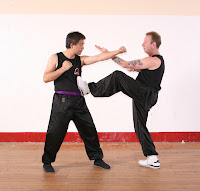Wing Chun Kung Fu - More Than Just Chain Punching
by Sifu John Agar
In this article I would like to introduce the reader to a number of different wing Chun hand techniques and their practical use in the art of self defense. Most people have heard of the Wing Chun chain punching techniques also sometimes referred to as the straight blast. Although this method of punching is well known it isn't the only form of hand techniques that Wing Chun utilizes within the system or in combat situations.
In this article I would like to introduce you to three other common hand techniques that are used in Wing Chun and which are just as equally important. They are the palm down knife hand strike (Chon Sau), the palm up knife hand strike (Inverted Chon Sau) and the hacking elbow (Pai Jang).
|
 Straight Punch |  Palm down Strike |  Palm up Strike |  Hacking Elbow |
In Wing Chun we refer to the common old saying of using the right tool for the right job. By this we mean that certain techniques will work better in certain situations and naturally follow when applied one after the other. Below are a couple of practical examples.
|
 Opponents face off against each other |  Attacker attacks with a punch, defender turns off with a bong Sau |  Defender does a Lap Sau and Palm down Strike |  Defender pulls attackers blocking arm and strikes with a palm up strike |  Defender performs a neck pull and hacking elbow strike |
In th
In the above sequence the opponents face off against each other in pre fighting positions. The person on the left attacks with a lead hand straight punch. The defender turn off his centre line and executes a right Bong sau (wing arm block) followed by a Lap Sau and Chon Sau (simultaneous pull down and palm down knife hand strike), the person on the left throws up his arm to protect his wind pipe from the on coming strike which is immediately pulled down to allow an opening for the Wing Chun exponent to execute his Inverted Chon Sau (palm up knife hand strike) to the neck. From this point the Wing Chun exponent continues his attack by reaching around the opponent's neck pulling him onto a Pai Jang (hacking elbow).
Below is another examle of using the right tool for the right job. This time it is classical Karate against Wing Chung.
|
 Opponents face off against each other |  Sifu Agar attacks with a head punch, Karate exponent blocks the on coming attack and gets ready to launch a reverse punch |  Karate exponent launches a reverse punch counter, Sifu Agar blocks Di Bong Sau, inverted Chon Sau |  Sifu Agar follows up attack with Jut Sau / Chon Sau |  Sifu Agar finishes with a rising elbow strike |
In the above sequence the two opponents once again face each other in a pre fighting position. Sifu Agar launches a staight head punch attack; this is countered ith an open hand block followed by a reverse punch. the reverse punch is countered by a simultaneous low Wing Arm Block (Di Bong Sau) and a palm up knife hand block (Inverted Chon Sau) this is immediately followed by a pressing down hand and simultaneous palm down knife hand blcok (Jut Sau, chon Sau). Sifu Agar finishes his opponent off with a rising elbow strike (Hay Jang).
Key Points
When the Karate exponent in the above sequence throws his reverse punch you must think of smothering his punch and at the same time hitting him with your palm up strike, then immediately drop your left hand down to monitor his arm and stirke at the same time, just think drop hit, drop hit!
Conclusion
These are just three of the common techniques used within Wing Chun system. Each strike should be trained repetitively and their offensive and defensive applications should be drilled to make them second nature just like every other technique you practice.
About the Author
Sifu John Agar is a professional Wing Chun instructor based in the North East of England. He has been teaching the art of Wing Chun Kung Fu for a period of over 30 years. He has recently formed his own Martial Arts film production company and has to date produced a series of 5 affordable Wing Chun Kung Fu videos. fours of these are aimed at the complete beginner focusing on the First form - Siu Lim Tao and the core techniques of Wing Chun to build a good foundation. He has also recently added a fifth video based around the second form in the system Chum Kiu. These can be downloaded straight to your home computer from his web site: www.martialartsinstructionalvideos.co.uk.
For further information on sifu Agar or any of his classes / private lessons then please visit: www.johnagarwingchun.co.uk
|




























